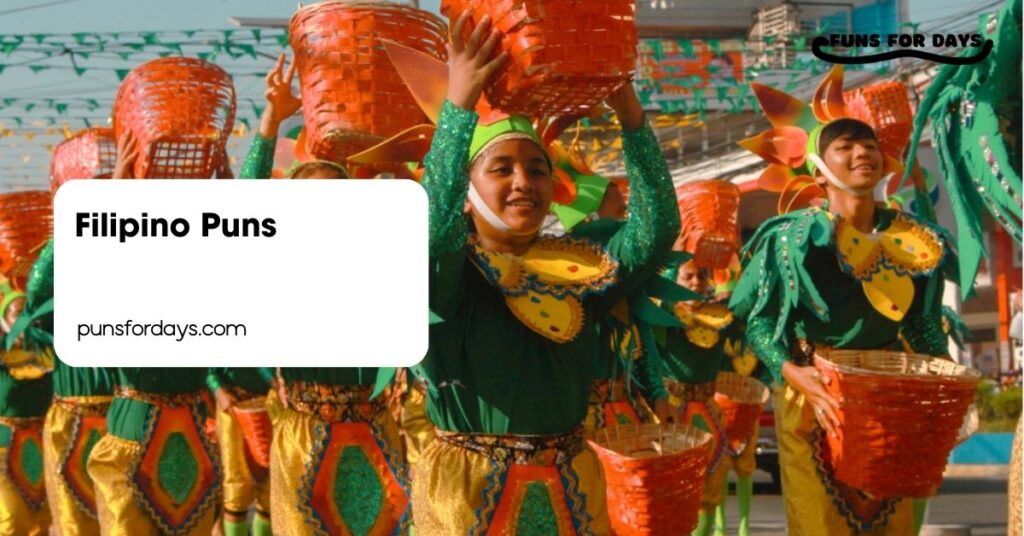If you think humor is universal, wait until you jump into the delightful industry of Filipino puns. These clever wordplays blend wit and culture, creating a unique comedic experience that’ll leave you chuckling. Whether you’re a native speaker or just dipping your toes into the language, Filipino puns offer a fun way to appreciate the richness of Filipino culture.
Imagine sharing a laugh with friends over a well-timed pun that captures the essence of everyday life. From food to relationships, these playful quips not only entertain but also connect you to the heart of Filipino storytelling. So get ready to explore the charm of Filipino puns and discover how they can brighten your day while giving you a glimpse into the vibrant Filipino spirit.
Filipino Puns: A Fun Way to Celebrate Language

Captivating with Filipino puns can be an entertaining way to appreciate the beauty of the language. These clever wordplays showcase the richness of Filipino culture while sparking laughter. Discovering puns helps you explore the nuances of Filipino expressions, revealing cultural insights along the way.
Using puns in conversations can foster deeper social connections among friends and family. Sharing these humorous twists promotes joy and camaraderie, making gatherings more lively and memorable. You’ll find that the playfulness in puns often reflects the lightheartedness of everyday life in the Philippines.
Learning puns also enhances your language skills and vocabulary. By hearing or reading these witty phrases, you’ll become more familiar with idiomatic expressions. Challenge yourself to remember and use these puns in your interactions, adding a layer of fun to your language-learning journey.
Enjoying Filipino puns can even bridge cultural gaps. Many people appreciate humor that comes from different backgrounds. When you present a pun, it often invites others to share their own jokes, fostering a sense of community and shared experience.
So, don’t hesitate to jump into the vibrant industry of Filipino puns. They enrich language while providing a delightful way to connect with others. Whether you share a pun at a party or slip one into a casual chat, the laughter that follows will surely make your day a little brighter.
Understanding Filipino Puns
Filipino puns add a lively twist to conversations and reflect the rich culture of the Philippines. You’ll find these clever wordplays intertwined with humor, food, and national symbols.
What Are Filipino Puns?
Filipino puns involve playful manipulation of words, often found in Tagalog and other Filipino languages. Clever uses of homophones and homographs create a delightful twist in expressions. For example, you might hear “Adobo you believe it?” or “Let’s make sinigang of fun.” These wordplays invite laughter by connecting everyday phrases to local cuisine, making them enjoyable for language learners and native speakers alike.
The Importance of Puns in Filipino Culture
Understanding puns is essential for grasping Filipino humor. You engage more deeply with cultural nuances when you appreciate these expressions. Puns serve not just as jokes but as a way to discuss national symbols and everyday life, improving local storytelling. For instance, when you hear a pun like “Mango-t it,” you discover how humor enriches social bonds, foster joy, and create lively interactions among friends and family. Embracing Filipino puns leads to shared laughter and builds connections in your social circles.
Popular Filipino Puns

Filipino puns are a delightful blend of wordplay and cultural humor. Enjoyment often comes from how these phrases connect to everyday experiences.
Everyday Filipino Puns
Adobo enthusiasts will surely chuckle at, “Why did the Adobo go to school? To get a little saucy!” This clever twist highlights a beloved dish while making you smile. Likewise, if you’re in the mood for a musical reference, “What’s a Filipino’s favorite type of music? OPM (Original Pancit Music)!” can resonate strongly, linking music with a popular noodle. Cultural references enrich the humor further. For instance, here’s a classic: “Ano’ng tawag sa flan nagkagalit? Leche.” Wordplay like this plays on shared experiences, allowing everyone to engage.
Filipino Puns in Literature
Writers often dabble in puns, showcasing linguistic creativity. For example, clever turns of phrase capture unique aspects of Filipino culture. In narratives, you might find characters captivating in wordplay to express their emotions. One hallmark pun is, “Anong hayop ang gustong maging presidente? Kalabaw, kasi ‘ka-labaw’ (collaborate) sa bayan.” This line beautifully marries wit and cultural context. Captivating with literature that includes puns allows you to appreciate the depth of Filipino storytelling.
Filipino Puns in Pop Culture
Pop culture is a vibrant arena for puns, bringing humor into everyday life. This playful language seeps into memes, television shows, and movies. You’ll encounter jokes like, “Bakit maswerte ang kalendaryo? Kasi maraming siyang date.” It’s wonderful how such humor can bring a smile while showcasing language skills. Social media is also flooded with these puns, making them easy to share with friends. The connection between humor and familiarity with culture truly enhances entertainment experiences.
Crafting Your Own Filipino Puns

Creating your own Filipino puns is a fun and creative process. You’ll find that mixing language with cultural references leads to delightful humor.
Tips for Creating Filipino Puns
- Incorporate Local Language and Dialects
Use words from languages like Tagalog or Cebuano for a local twist. Words like “sinigang,” “adobo,” and “lechon” often elicit laughs due to their association with beloved dishes.
- Draw on Cultural References
Base your puns on Filipino culture, including food, festivals, and national symbols. Think of playful connections with popular foods or customs, making your puns relatable and funny.
- Use Wordplay and Double Meanings
Exploit the double meanings of words to enhance humor. For instance, you might say, “What did the Filipino chef say to his soup? It’s time to ‘sinigang’ it out!” Here, the play on words creates a light-hearted twist on a common phrase.
- Experiment with Rhymes
Play around with words that rhyme or sound similar. You could say something like, “Feeling a little ‘lechon-corn?’ Time for a feast!” Rhymes can make your jokes more catchy and memorable.
- Keep It Simple and Fun
The best puns are often straightforward. Try phrases that make people chuckle without needing an explanation. Simple jokes resonate well.
Common Themes in Filipino Puns
- Food and Cuisine
Filipino dishes are a goldmine for puns. You can connect humor to meals like “kare-kare” or “lumpia” to engage your audience and elicit smiles.
- Festivals and Celebrations
Many puns draw inspiration from famous Filipino festivals. You might say, “Why did the fiesta go broke? It lost all its ‘cash-a-ron’!” Celebrations can create hilarious contexts for wordplay.
- Everyday Life and Customs
Incorporating elements from daily routines offers a relatable backdrop for humor. Phrases about family gatherings or local practices can quickly become punchlines.
- Language Play
Jump into the nuances of words and their meanings. Explore homophones and homographs to find clever twists, such as “Anong ulam ang maligayang araw? ‘Adobong’ makulay!” (colorful means happy).
- Cultural References and National Symbols
Tap into symbols like the jeepney or the Philippine eagle for fun associations. Trying phrases like “Why don’t jeepneys ever get lost? They always take the ‘road less traveled’!” can create laughter through shared experiences.
The Impact of Filipino Puns

Filipino puns significantly shape cultural interactions and communications. They add a fun spin to conversations while reflecting the vibrant nature of Filipino society.
Improving Communication with Filipino Puns
Filipino puns enrich communication by creating a playful atmosphere. Humor often serves as a bridge, connecting people through shared laughter. Using clever phrases encourages fluency in English and allows speakers to showcase their language skills. For example, when someone quips, “Adobo you believe it?” it not only elicits a smile but also highlights cultural references. These puns foster a sense of belonging, making interactions feel more personal. Also, they serve as an effective coping mechanism amid stress, as shared humor strengthens social bonds.
Filipino Puns in Social Media
Social media plays a crucial role in spreading Filipino puns. Platforms like Facebook and Twitter buzz with witty phrases and clever wordplay that resonate with many users. Often, memes featuring Filipino puns gain traction quickly, allowing humor to reach wider audiences. You might encounter a pun like “What’s a Filipino’s favorite type of music? OPM (Original Pancit Music)!” while scrolling, sparking laughter and engagement. Puns shared online reflect everyday experiences, making them relatable and appealing. Besides, social media enhances the accessibility of Filipino humor, allowing anyone to partake in the joy of wordplay.
Conclusion
Embracing Filipino puns opens up a delightful avenue for connection and understanding. These clever wordplays not only enhance your language skills but also immerse you in the rich tapestry of Filipino culture. Whether you’re sharing a laugh with friends or exploring the nuances of everyday conversations, puns bring a unique charm to interactions.
As you navigate through the vibrant industry of Filipino humor, you’ll find that these witty phrases foster camaraderie and create memorable experiences. So go ahead and sprinkle some puns into your conversations. You’ll not only entertain but also strengthen bonds with those around you. Enjoy the laughter and the connections that come with it.
Frequently Asked Questions
What are Filipino puns?
Filipino puns are clever wordplay that often utilizes homophones and homographs in Tagalog and other Filipino languages. They blend humor with cultural elements, making them a delightful way to engage with the richness of Filipino culture.
How do Filipino puns enhance social connections?
Using puns in conversations fosters joy and camaraderie among friends and family, making gatherings more lively. These witty phrases create shared laughter, helping to strengthen social bonds and deepen relationships.
Why are Filipino puns important for language learners?
Learning Filipino puns enhances vocabulary and language skills while providing insights into cultural nuances. They serve as a fun way for language learners to engage with the Filipino language and connect with native speakers.
Can you give examples of popular Filipino puns?
Sure! Some popular Filipino puns include “Adobo you believe it?” and “Why did the Adobo go to school? To get a little saucy!” These examples highlight the humor that connects everyday phrases to local cuisine.
How do puns appear in Filipino literature and pop culture?
Puns play a significant role in Filipino literature and pop culture, allowing writers to express emotions and capture cultural nuances. They can also be found in memes, television shows, and movies, making humor more accessible through social media.
What is the impact of Filipino puns on cultural communication?
Filipino puns create a playful atmosphere that fosters a sense of belonging. They serve as a bridge, connecting people through shared humor, and facilitating communication across cultural lines.







